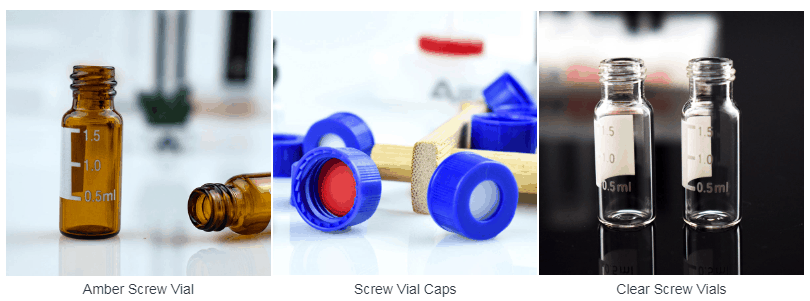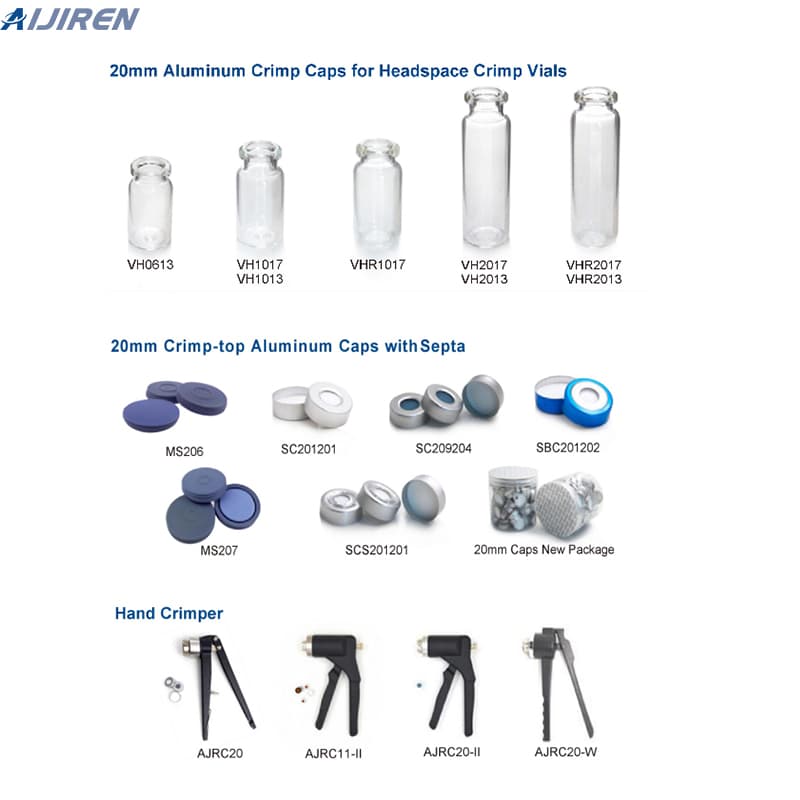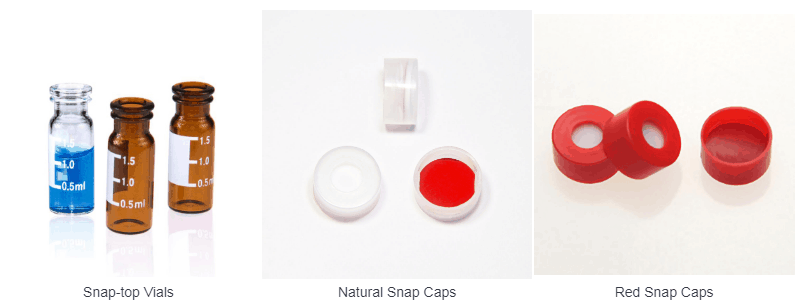Feb. 2nd, 2023
Types of Vials
Vials are available in three closure types; screw, crimp, snap, and cap. The closures have advantages and disadvantages.
Screw Cap Vials
Screw Cap Vials are universal. Screwing the cap applies a mechanical force that squeezes the septum between the glass rim and the cap. Screw caps form an excellent seal and mechanically hold the septum in place during piercing. No tools are required for assembly.
Overview of Common Materials
Glass
Glass screw cap vials are an ideal choice for many laboratory applications due to their inherent chemical resistance and transparency, providing a barrier against contamination while protecting samples that need to remain intact. Amber or colored variants are also available to shield light-sensitive substances. Their inertness makes them suitable for an array of chemical and biological applications.
Plastic
Plastic screw cap vials, made from polypropylene or other polymers, offer several distinct advantages over their glass counterparts: lightweight, shatter-resistance and cost-effectiveness are among them. Ideal for applications where breakage risks are present; disposable or one-use scenarios may also prefer plastic vials as they come in various colors to help differentiate samples more clearly while often accommodating various substances more safely.
Explore the superiority of glass chromatography vials over plastic counterparts by delving into our article. Discover the reasons why glass reigns supreme!:Top 3 Reasons Why Glass Chromatography Vials are Better Than Plastic Vials

Advantages of Screw Cap Vials
1. Easy to open and close
2. Suitable for repetitive use
3. Wide range of cap materials
Disadvantages of Screw Cap Vials
1.Limited compatibility with high-temperature applications
2. Potential for contamination due to multiple openings and closings
Range of Sizes and Configurations
Screw cap vials come in various sizes to accommodate diverse sample volumes, from microscale to larger capacities. Common sizes for these vials include 2 mL, 4 mL, 8 mL and 20 mL capacities - these different capacities provide flexibility to suit different experiments or analyses as well as laboratory techniques or instrumentation requirements.
Note :
On cap tightening: This is the mechanism that forms the seal and holds the septum in place during needle insertion. There is no need to over-tighten the cap, this can compromise the seal and lead to dislodging. The septum begins to cup or indent when you begin to over-tighten.
Crimp Cap Vials
Crimp Vials squeeze the septum between the rim of the glass vial and the crimped aluminum cap. This forms an excellent seal preventing evaporation. The septum stays seated during piercing by the autosampler needle. The crimp cap vial requires crimping tools to carry out the sealing process. For low-volume settings, manual crimper tools are the choice. For high-volume settings, automated crimpers are available.
Advantages of Crimp Vials:
1. Secure sealing
2. Minimal dead volume
3. Compatible with high-temperature applications
Disadvantages of Crimp Vials:
1. Require crimping tool
2. Not suitable for repetitive use

Snap Cap Vials
Snap Cap Vials are an extension of the crimp cap system of sealing. A plastic cap is stretched over the rim of the vial to form a seal by squeezing the septum between the glass and the stretched plastic cap. Plastic has memory and wants to return to its original dimension. This tension in the cap to return to its original size is the force forming the seal between the glass, cap, and septum. The advantage of a plastic snap cap is no tools are required to assemble it. The snap-top cap is a compromise sealing system.
Advantages of Snap Vials:
1. No crimping tool required
2. Straight interior shape for automated handling
3. Compatible with a wide range of instruments
Disadvantages of Snap Vials:
1. Higher cost compared to crimp vials
2. Limited compatibility with high-temperature applications
Note:
If the fit of the cap is very tight, they are hard to apply and may be subject to cracking.
If the fit is too loose, the seal is not very good, and the septa may be subject to dislodging.

Some more tips:
Based on our years of chromatography vial experience, crimp-cap vials are most situations best for GC and GC/MS analysis, while screw-cap vials are a better choice used for most HPLC and LC-MS applications. However, your personal preference and specific chromatography experiment requirements are also important factors to consider.
Considerations for Selecting a Vial
A. Type of Analysis
The vial's compatibility with your instrument depends on the sort of analysis you conduct. Before selecting a vial, make sure it is compatible with the instrument because some require a particular kind of vial.
B. Sample Volume and Type
The vial selection can also be influenced by the sample type and volume. To prevent chemical reactions, some samples may need a particular kind of vial or cap material. The size of the vial needed can also be determined by the sample volume.
C. Pressure and Temperature
The vial selection may also be influenced by the analysis's temperature and pressure. Vials with a crimp can be used in high-temperature settings, whereas those with a screw closure might not be.
D. Cost
The price of the vial must also be taken into account. Although crimp vials require a crimping tool, they may be more affordable than snap or screw closure vials. Snap vials don't need a crimping tool, but they may cost more.
Compatible Autosamplers of 2ml HPLC Screw Cap
The compatibility of 2ml screw cap vials with specific autosamplers involves consideration of the vial dimensions, closure design, and the autosampler's vial tray or rack. Here are details for some commonly used autosampler models:
Agilnt Technologies:
Compatible Autosamplers: Agilnt 1100, 1200, 1260, and 1290 Series Autosamplers.
Vial Compatibility: Agilnt-compatible 2ml screw cap vials with appropriate dimensions.
Waters:
Compatible Autosamplers: Waters Alliance HT/Alliance HPLC Systems.
Vial Compatibility: Waters-compatible 2ml screw cap vials designed for Alliance systems.
Thermo Fisher:
Compatible Autosamplers: Thermo Fisher Dionex HPLC Systems (e.g., Ultimate 3000 series).
Vial Compatibility: Thermo Fisher-compatible 2ml screw cap vials suitable for Dionex HPLC Autosamplers.
Shimadzu:
Compatible Autosamplers: Shimadzu Nexera and Prominence Series.
Vial Compatibility: Shimadzu-compatible 2ml screw cap vials fitting Nexera and Prominence Autosamplers.
Before making a selection, it's crucial to refer to the autosampler's user manual or specifications provided by the manufacturer. Additionally, ensure that the chosen 2ml screw cap vials meet the required quality standards and dimensions specified by both the vial and autosampler manufacturers to guarantee optimal compatibility and performance.
In Conclusion
Choosing the right vial is crucial for achieving accurate and reliable results in chromatography. The most typical vial types used in chromatography are crimp vials, snap vials, and screw cap vials. The choice of vial is based on the type of analysis, sample type and volume, temperature and pressure, and cost. Each type of vial has advantages and disadvantages. Before selecting a vial, it is crucial to take into account these variables to make sure the vial is compatible with your instrument and sample and yields accurate and dependable findings.
What to pay Attention to:
Snap Cap is fast to seal but sealing strength is not as good as crimp and screw vials. However, even though both types of crimp and screw vials have a good seal, crimp vials provide an additional guarantee of sealing for food, forensics, and other applications for which you want to avoid sample tampering. A crimping sealing is also recommended for the storage of volatile compounds.
Contact us now
If you want to buy HPLC vial of Aijiren, please contact us by the following five ways. We will reply to you as soon as possible.
1.Leave a message at our official website
2.Contact our online customer service at lower right window
3.Whatsapp me directly: +8618057059123
4.Mail me directly:market@aijirenvial.com
5.Call me Directly:8618057059123
Unlock insights on HPLC vials with 50 detailed answers by exploring our comprehensive article. Your key to in-depth knowledge awaits:50 Most Frequently Asked Questions on HPLC Vials
And
For more knowledge about vial choosing, this article is also useful: 5 Points Need to Consider When Choosing An Autosampler Vial


 English
English
 Chinese
Chinese



